#mongoose npm
Explore tagged Tumblr posts
Text
Mongoose npm for nodejs 2023
Mongoose is a widely-used Node.js library that provides a straightforward and elegant way to interact with MongoDB, a popular open-source NoSQL database. Developed to simplify database management and streamline interactions between applications and MongoDB, Mongoose offers an object modeling system that enables developers to define schemas, validate data, and perform CRUD (Create, Read, Update, Delete) operations with ease. Read More..
1 note
·
View note
Text
Prisma Vs Mongoose
When working with MongoDB in Node.js applications, developers often choose between Prisma and Mongoose. Both are powerful tools, but they cater to different needs and offer unique features…
#prisma#mongoose#reactjs#react#mern#mernstack#mongodb#nosql#javascript#js#nodejs#npm#prismaorm#orm#database#databaseconnectivity#developers#developer#software#softwaredeveloper#programming#programminglanguage#javascriptprogramming#advancedjavascript
1 note
·
View note
Text
Certainly! Let’s explore how to build a full-stack application using Node.js. In this comprehensive guide, we’ll cover the essential components and steps involved in creating a full-stack web application.
Building a Full-Stack Application with Node.js, Express, and MongoDB
1. Node.js: The Backbone of Our Application
Node.js is a runtime environment that allows us to run JavaScript on the server-side.
It’s built on Chrome’s V8 JavaScript engine and uses an event-driven, non-blocking I/O model, making it lightweight and efficient.
Node.js serves as the backbone of our application, providing the environment in which our server-side code will run.
2. Express.js: Simplifying Server-Side Development
Express.js is a minimal and flexible Node.js web application framework.
It provides a robust set of features for building web and mobile applications.
With Express.js, we can:
Set up middlewares to respond to HTTP requests.
Define routing rules.
Add additional features like template engines.
3. MongoDB: Storing Our Data
MongoDB is a document-oriented database program.
It uses JSON-like documents with optional schemas and is known for its flexibility and scalability.
We’ll use MongoDB to store our application’s data in an accessible and writable format.
Building Our Full-Stack Application: A Step-by-Step Guide
Setting Up the Environment:
Install Node.js:sudo apt install nodejs
Initialize a new Node.js project:mkdir myapp && cd myapp npm init -y
Install Express.js:npm install express
Creating the Server:
Create a basic Express server:const express = require('express'); const app = express(); const port = 3000; app.get('/', (req, res) => { res.send('Hello World!'); }); app.listen(port, () => { console.log(`Server running at http://localhost:${port}`); });
Defining Routes:
Define routes for different parts of our application:app.get('/user', (req, res) => { res.send('User Page'); });
Connecting to MongoDB:
Use Mongoose (a MongoDB object modeling tool) to connect to MongoDB and handle data storage.
Remember, this is just the beginning! Full-stack development involves frontend (client-side) work as well. You can use React, Angular, or other frontend libraries to build the user interface and connect it to your backend (Node.js and Express).
Feel free to explore more about each component and dive deeper into building your full-stack application! 😊 12
2 notes
·
View notes
Text
Importance of MERN Stack
What is MERN Stack?
Four essential technologies make up the full-stack JavaScript framework MERN Stack:
MongoDB: A NoSQL database system known for its flexibility and scalability, MongoDB stores data in a JSON-like format, making it ideal for handling large volumes of data.
Express.js: A minimalist web application framework for Node.js, Express.js simplifies the process of building robust and scalable web applications by providing a set of features for web and mobile applications.
React.js: Developed by Facebook, React.js is a powerful JavaScript library for building interactive user interfaces. Its component-based architecture allows developers to create reusable UI components, resulting in a more modular and maintainable codebase.
Node.js: A server-side JavaScript runtime environment, Node.js enables developers to build fast and scalable network applications. With its event-driven, non-blocking I/O model, Node.js is well-suited for building real-time web applications.
Why Choose MERN Stack?
Streamlined Development: With MERN Stack, developers can leverage the power of JavaScript across the entire development stack, from frontend to backend. This unified approach reduces development time and eliminates the need to switch between different programming languages and frameworks.
SEO-Friendly Architecture: MERN Stack's server-side rendering capabilities, coupled with its support for modern JavaScript frameworks like React.js, make it highly SEO-friendly. This ensures that web applications built with MERN Stack are easily discoverable by search engines, leading to improved search engine rankings and increased organic traffic.
Optimized Performance: MERN Stack's asynchronous, non-blocking architecture allows for seamless communication between frontend, backend, and database components, resulting in faster response times and improved performance. This translates to a smoother user experience and higher customer satisfaction.
Improved Security: In today's digital environment, security is of the highest priority. MERN Stack provides built-in security features, such as authentication and authorization mechanisms, as well as support for encryption and data validation, to ensure that web applications are protected against common security threats.
Scalability and Flexibility: Whether you're building a small-scale application or a large-scale enterprise solution, MERN Stack offers the scalability and flexibility you need to grow and adapt to changing business requirements. With its modular architecture and support for microservices, MERN Stack allows for easy scaling and maintenance of complex applications.
Getting Started with MERN Stack
Are you prepared to explore the MERN Stack world? Here is a detailed how-to for getting started:
Install Node.js: Begin by installing Node.js, which includes npm (Node Package Manager), on your local machine. Node.js will serve as the runtime environment for your server-side code.
Set Up MongoDB: Install MongoDB, a NoSQL database system, and set up a local or remote MongoDB instance to store your application data.
Create an Express.js Server: Use Express.js to create a server-side application that will handle HTTP requests and serve as the backend for your web application.
Build Your React.js Frontend: Use React.js to create a client-side application that will handle user interface interactions and communicate with the backend server.
Integrate MongoDB with Express.js: Connect your Express.js server to your MongoDB database using Mongoose, a MongoDB object modeling tool for Node.js.
Deploy Your Application: Once your application is complete, deploy it to a hosting provider of your choice to make it accessible to users worldwide.
Conclusion
MERN Stack offers a powerful and versatile framework for building modern web applications that are fast, scalable, and secure. Whether you're a seasoned developer or just getting started, MERN Stack provides the tools and resources you need to bring your ideas to life. So why wait? Start exploring the endless possibilities of MERN Stack today and unlock the potential of your web development projects with Meander Training, Meander training is a platform where you can start your web development journey, it provides industrial training with certification.
1 note
·
View note
Text
You can learn NodeJS easily, Here's all you need:
1.Introduction to Node.js
• JavaScript Runtime for Server-Side Development
• Non-Blocking I/0
2.Setting Up Node.js
• Installing Node.js and NPM
• Package.json Configuration
• Node Version Manager (NVM)
3.Node.js Modules
• CommonJS Modules (require, module.exports)
• ES6 Modules (import, export)
• Built-in Modules (e.g., fs, http, events)
4.Core Concepts
• Event Loop
• Callbacks and Asynchronous Programming
• Streams and Buffers
5.Core Modules
• fs (File Svstem)
• http and https (HTTP Modules)
• events (Event Emitter)
• util (Utilities)
• os (Operating System)
• path (Path Module)
6.NPM (Node Package Manager)
• Installing Packages
• Creating and Managing package.json
• Semantic Versioning
• NPM Scripts
7.Asynchronous Programming in Node.js
• Callbacks
• Promises
• Async/Await
• Error-First Callbacks
8.Express.js Framework
• Routing
• Middleware
• Templating Engines (Pug, EJS)
• RESTful APIs
• Error Handling Middleware
9.Working with Databases
• Connecting to Databases (MongoDB, MySQL)
• Mongoose (for MongoDB)
• Sequelize (for MySQL)
• Database Migrations and Seeders
10.Authentication and Authorization
• JSON Web Tokens (JWT)
• Passport.js Middleware
• OAuth and OAuth2
11.Security
• Helmet.js (Security Middleware)
• Input Validation and Sanitization
• Secure Headers
• Cross-Origin Resource Sharing (CORS)
12.Testing and Debugging
• Unit Testing (Mocha, Chai)
• Debugging Tools (Node Inspector)
• Load Testing (Artillery, Apache Bench)
13.API Documentation
• Swagger
• API Blueprint
• Postman Documentation
14.Real-Time Applications
• WebSockets (Socket.io)
• Server-Sent Events (SSE)
• WebRTC for Video Calls
15.Performance Optimization
• Caching Strategies (in-memory, Redis)
• Load Balancing (Nginx, HAProxy)
• Profiling and Optimization Tools (Node Clinic, New Relic)
16.Deployment and Hosting
• Deploying Node.js Apps (PM2, Forever)
• Hosting Platforms (AWS, Heroku, DigitalOcean)
• Continuous Integration and Deployment-(Jenkins, Travis CI)
17.RESTful API Design
• Best Practices
• API Versioning
• HATEOAS (Hypermedia as the Engine-of Application State)
18.Middleware and Custom Modules
• Creating Custom Middleware
• Organizing Code into Modules
• Publish and Use Private NPM Packages
19.Logging
• Winston Logger
• Morgan Middleware
• Log Rotation Strategies
20.Streaming and Buffers
• Readable and Writable Streams
• Buffers
• Transform Streams
21.Error Handling and Monitoring
• Sentry and Error Tracking
• Health Checks and Monitoring Endpoints
22.Microservices Architecture
• Principles of Microservices
• Communication Patterns (REST, gRPC)
• Service Discovery and Load Balancing in Microservices
1 note
·
View note
Text
Authentication and Authorization in Node.js with JWT

Authentication and authorization are essential for securing modern web applications. In Node.js, using JWT (JSON Web Tokens) has become a trending and efficient way to handle secure access control. JWT allows stateless authentication, making it ideal for RESTful APIs and microservices architecture.
When a user logs in, the server generates a JWT signed with a secret key or a private key (in case of RSA). This token is then sent to the client and stored typically in localStorage or HTTP-only cookies. For each subsequent request, the client sends the token in the header, commonly using the Bearer schema.
The backend uses middleware like jsonwebtoken in combination with Express.js to verify the token and extract user information. If the token is valid, the user gets access to protected routes and resources. Role-based access control (RBAC) can also be implemented to allow specific users access to different parts of the application.
JWTs are widely used in Node.js for API security, real-time applications, and mobile backends due to their lightweight and stateless nature. Key trends include integrating JWT with OAuth2.0, using refresh tokens for long-lived sessions, and enhancing security with HTTPS and token expiration strategies.
Popular npm packages include jsonwebtoken, bcryptjs for password hashing, and dotenv for environment variables. Combining JWT with MongoDB, Mongoose, and Express.js is a common stack for secure backend development in 2025.
0 notes
Text
Backend Web Development Using Node.js

Node.js has revolutionized web development by enabling developers to write server-side code using JavaScript. If you're already comfortable with JavaScript on the frontend, transitioning to backend development with Node.js is a logical next step. In this post, we'll introduce the fundamentals of backend development using Node.js and how to build scalable, efficient web applications.
What is Node.js?
Node.js is a JavaScript runtime built on Chrome’s V8 engine. It allows developers to use JavaScript to write backend code, run scripts outside the browser, and build powerful network applications. Node.js is known for its non-blocking, event-driven architecture, making it highly efficient for I/O-heavy applications.
Why Use Node.js for Backend Development?
JavaScript Everywhere: Use a single language for both frontend and backend.
Asynchronous and Non-blocking: Great for handling many connections at once.
Vast Ecosystem: Thousands of modules available via npm (Node Package Manager).
Scalability: Ideal for microservices and real-time applications like chats or games.
Setting Up a Node.js Project
Install Node.js from nodejs.org
Create a new project folder:
Initialize the project:
Create your main file:
Basic Server Example
const http = require('http'); const server = http.createServer((req, res) => { res.writeHead(200, {'Content-Type': 'text/plain'}); res.end('Hello, Node.js Backend!'); }); server.listen(3000, () => { console.log('Server running on http://localhost:3000'); });
Using Express.js for Easier Development
Express.js is a popular web framework for Node.js that simplifies routing and middleware management.npm install express const express = require('express'); const app = express(); app.get('/', (req, res) => { res.send('Welcome to the Node.js backend!'); }); app.listen(3000, () => { console.log('Express server running on http://localhost:3000'); });
Common Backend Tasks with Node.js
Handle routing and API endpoints
Connect to databases (MongoDB, PostgreSQL, etc.)
Manage user authentication and sessions
Process form data and JSON
Serve static files
Popular Libraries and Tools
Express.js: Web framework
Mongoose: MongoDB object modeling
dotenv: Environment variable management
JWT: JSON Web Tokens for authentication
Nodemon: Auto-restart server on code changes
Best Practices
Use environment variables for sensitive data
Structure your project using MVC or service-based architecture
Use middleware for error handling and logging
Validate and sanitize user input
Secure your APIs with authentication and rate-limiting
Conclusion
Node.js is a powerful and flexible choice for backend development. Its ability to use JavaScript on the server-side, combined with a rich ecosystem of libraries, makes it ideal for building modern web applications. Start small, experiment with Express, and gradually add more features to build robust backend services.
0 notes
Text
CodeBattle: The Ultimate 1v1 Real-Time Coding Battle Platform
Introduction
Hello coder! How are you , In the world of competitive programming and coding challenges, real-time battles are becoming increasingly popular. CodeBattle is a cutting-edge 1v1 real-time coding battle platform designed to test programmers’ skills in a fast-paced MCQ-based format. Whether you’re a beginner or an experienced coder, CodeBattle offers an exciting and challenging way to improve your coding knowledge.
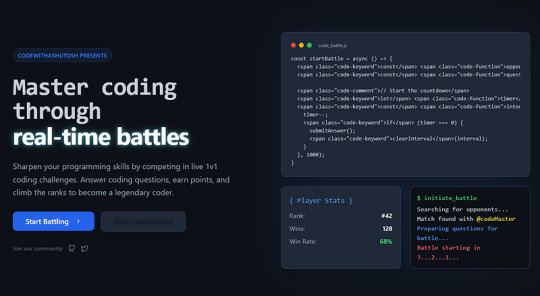
In this article, we will dive deep into the development of CodeBattle, covering project structure, technology stack, real-time matchmaking, styling tips, and live demo setup. Additionally, we will provide code snippets to help you understand the implementation better.
Features of CodeBattle
Real-time 1v1 Coding Battles
MCQ-based Questions with a 20-second timer
Live Scoreboard
Leaderboard System (Daily, Weekly, and All-time Rankings)
Secure Authentication (Google/Firebase Login)
Admin Panel to manage questions & users
Fully Responsive UI
Tech Stack: React (Next.js), Node.js, Express.js, MongoDB, and Socket.io
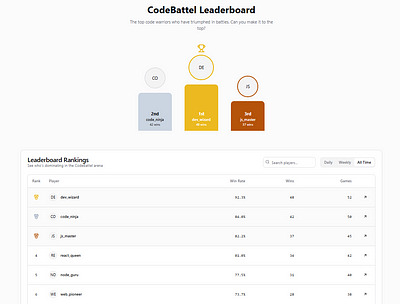
Project Structure
CodeBattel/ ├── frontend/ # React (Next.js) UI │ ├── components/ # Reusable Components │ ├── pages/ # Next.js Pages (Home, Play, Leaderboard, etc.) │ ├── styles/ # CSS Modules / Tailwind CSS │ └── utils/ # Helper Functions │ ├── backend/ # Node.js Backend │ ├── models/ # MongoDB Models │ ├── routes/ # Express Routes (API Endpoints) │ ├── controllers/ # Business Logic │ ├── config/ # Configuration Files │ ├── socket/ # Real-time Matchmaking with Socket.io │ └── index.js # Main Server Entry Point │ └── README.md # Project Documentation
Building the Frontend with React (Next.js)
1. Installing Dependencies
npx create-next-app@latest codebattel cd codebattel npm install socket.io-client axios tailwindcss npm install --save firebase
2. Setting up Tailwind CSS
npx tailwindcss init -p
Edit tailwind.config.js:module.exports = { content: ["./pages/**/*.{js,ts,jsx,tsx}", "./components/**/*.{js,ts,jsx,tsx}"], theme: { extend: {}, }, plugins: [], };
Developing the 1v1 Battle System
1. Setting Up Real-Time Matchmaking
import { io } from "socket.io-client"; import { useEffect, useState } from "react";const socket = io("http://localhost:5000");export default function BattleRoom() { const [question, setQuestion] = useState(null); const [timer, setTimer] = useState(20); useEffect(() => { socket.emit("joinBattle"); socket.on("newQuestion", (data) => { setQuestion(data); setTimer(20); }); }, []); return ( <div> <h1>CodeBattel</h1> {question && ( <div> <h2>{question.text}</h2> <ul> {question.options.map((opt, index) => ( <li key={index}>{opt}</li> ))} </ul> <p>Time Left: {timer} sec</p> </div> )} </div> ); }
Building the Backend with Node.js & Socket.io
1. Installing Dependencies
npm init -y npm install express socket.io mongoose cors dotenv
2. Creating the Server
const express = require("express"); const http = require("http"); const { Server } = require("socket.io"); const app = express(); const server = http.createServer(app); const io = new Server(server, { cors: { origin: "*" } });let rooms = []; io.on("connection", (socket) => { socket.on("joinBattle", () => { if (rooms.length > 0) { let room = rooms.pop(); socket.join(room); io.to(room).emit("newQuestion", { text: "What is React?", options: ["Library", "Framework", "Language", "None"] }); } else { let newRoom = "room-" + socket.id; rooms.push(newRoom); socket.join(newRoom); } }); });server.listen(5000, () => console.log("Server running on port 5000"));
Live Demo Setup
Clone the repo:
git clone https://github.com/ashutoshmishra52/codebattel.git cd codebattel
Install dependencies:
npm install && cd backend && npm install
Run the project:
npm run dev
Open http://localhost:3000 in your browser.
FAQ
Q1: What is CodeBattle?
CodeBattle is a 1v1 real-time coding battle platform where players answer multiple-choice questions under a 20-second timer.
Q2: How does matchmaking work?
Players are randomly paired in real time using Socket.io.
Q3: Can I add my own questions?
Yes! The Admin Panel allows you to add/edit/delete MCQs.
Q4: How do I contribute?
Check out the GitHub repository and submit a pull request.
About the Author
Ashutosh Mishra is a full-stack developer, AI researcher, and content writer with 4+ years of experience. He is the founder of CodeWithAshutosh, a platform dedicated to teaching web development, AI, and competitive coding.
For more coding tutorials and projects, follow Ashutosh Mishra.
Conclusion
CodeBattle is an innovative way to enhance your coding skills in a competitive environment. With real-time battles, an engaging UI, and a powerful backend, it stands out as a top-tier coding battle platform. Start coding, challenge your friends, and rise up the leaderboard!
0 notes
Text
A Guide to Creating APIs for Web Applications

APIs (Application Programming Interfaces) are the backbone of modern web applications, enabling communication between frontend and backend systems, third-party services, and databases. In this guide, we’ll explore how to create APIs, best practices, and tools to use.
1. Understanding APIs in Web Applications
An API allows different software applications to communicate using defined rules. Web APIs specifically enable interaction between a client (frontend) and a server (backend) using protocols like REST, GraphQL, or gRPC.
Types of APIs
RESTful APIs — Uses HTTP methods (GET, POST, PUT, DELETE) to perform operations on resources.
GraphQL APIs — Allows clients to request only the data they need, reducing over-fetching.
gRPC APIs — Uses protocol buffers for high-performance communication, suitable for microservices.
2. Setting Up a REST API: Step-by-Step
Step 1: Choose a Framework
Node.js (Express.js) — Lightweight and popular for JavaScript applications.
Python (Flask/Django) — Flask is simple, while Django provides built-in features.
Java (Spring Boot) — Enterprise-level framework for Java-based APIs.
Step 2: Create a Basic API
Here’s an example of a simple REST API using Express.js (Node.js):javascriptconst express = require('express'); const app = express(); app.use(express.json());let users = [{ id: 1, name: "John Doe" }];app.get('/users', (req, res) => { res.json(users); });app.post('/users', (req, res) => { const user = { id: users.length + 1, name: req.body.name }; users.push(user); res.status(201).json(user); });app.listen(3000, () => console.log('API running on port 3000'));
Step 3: Connect to a Database
APIs often need a database to store and retrieve data. Popular databases include:
SQL Databases (PostgreSQL, MySQL) — Structured data storage.
NoSQL Databases (MongoDB, Firebase) — Unstructured or flexible data storage.
Example of integrating MongoDB using Mongoose in Node.js:javascriptconst mongoose = require('mongoose'); mongoose.connect('mongodb://localhost:27017/mydb', { useNewUrlParser: true, useUnifiedTopology: true });const UserSchema = new mongoose.Schema({ name: String }); const User = mongoose.model('User', UserSchema);app.post('/users', async (req, res) => { const user = new User({ name: req.body.name }); await user.save(); res.status(201).json(user); });
3. Best Practices for API Development
🔹 Use Proper HTTP Methods:
GET – Retrieve data
POST – Create new data
PUT/PATCH – Update existing data
DELETE – Remove data
🔹 Implement Authentication & Authorization
Use JWT (JSON Web Token) or OAuth for securing APIs.
Example of JWT authentication in Express.js:
javascript
const jwt = require('jsonwebtoken'); const token = jwt.sign({ userId: 1 }, 'secretKey', { expiresIn: '1h' });
🔹 Handle Errors Gracefully
Return appropriate status codes (400 for bad requests, 404 for not found, 500 for server errors).
Example:
javascript
app.use((err, req, res, next) => { res.status(500).json({ error: err.message }); });
🔹 Use API Documentation Tools
Swagger or Postman to document and test APIs.
4. Deploying Your API
Once your API is built, deploy it using:
Cloud Platforms: AWS (Lambda, EC2), Google Cloud, Azure.
Serverless Functions: AWS Lambda, Vercel, Firebase Functions.
Containerization: Deploy APIs using Docker and Kubernetes.
Example: Deploying with DockerdockerfileFROM node:14 WORKDIR /app COPY package.json ./ RUN npm install COPY . . CMD ["node", "server.js"] EXPOSE 3000
5. API Testing and Monitoring
Use Postman or Insomnia for testing API requests.
Monitor API Performance with tools like Prometheus, New Relic, or Datadog.
Final Thoughts
Creating APIs for web applications involves careful planning, development, and deployment. Following best practices ensures security, scalability, and efficiency.
WEBSITE: https://www.ficusoft.in/python-training-in-chennai/
0 notes
Text
Pelatihan Node.js Developer di Bali: Pelatihan SDM Indonesia

Pelatihan Node.js adalah salah satu teknologi yang paling dicari di industri pengembangan web saat ini. Node.js memungkinkan developer untuk membangun aplikasi web dengan performa tinggi menggunakan JavaScript, bahasa pemrograman yang sudah dikenal luas. Di Bali, pelatihan Node.js Developer memberikan kesempatan langka untuk menguasai teknologi ini di bawah bimbingan para ahli, sambil menikmati keindahan pulau dewata.
Kurikulum Pelatihan Node.js Developer yang Terintegrasi
Pelatihan ini dirancang dengan kurikulum yang komprehensif dan terstruktur, sehingga para peserta dapat mempelajari Node.js mulai dari dasar hingga tingkat lanjutan. Berikut adalah beberapa topik penting yang akan dibahas dalam pelatihan ini:
1. Pengenalan Node.js dan JavaScript
Kami memulai pelatihan dengan pengenalan mendalam mengenai Node.js dan JavaScript. JavaScript adalah dasar dari pengembangan Node.js, sehingga pemahaman yang kuat tentang bahasa ini sangat penting. Para peserta akan belajar mengenai:
Sintaks dasar JavaScript
Asynchronous programming
Event-driven architecture
Modul dan paket NPM
2. Membangun API dengan Express.js
Express.js adalah framework yang populer digunakan dengan Node.js untuk membangun aplikasi web dan API. Pada sesi ini, peserta akan diajarkan bagaimana membuat RESTful API menggunakan Express.js. Materi yang akan dibahas meliputi:
Instalasi dan konfigurasi Express.js
Routing dan middleware
Error handling dan validasi
Integrasi dengan database seperti MongoDB
3. Pengelolaan Database dengan MongoDB
Pelatihan ini juga mencakup pengajaran mengenai MongoDB, database NoSQL yang sangat cocok untuk aplikasi berbasis Node.js. Dalam sesi ini, peserta akan belajar:
Dasar-dasar MongoDB
Operasi CRUD (Create, Read, Update, Delete)
Mongoose: ODM (Object Data Modeling) untuk MongoDB
Optimasi performa database
4. Pengujian dan Debugging Aplikasi Node.js
Salah satu aspek penting dalam pengembangan aplikasi adalah pengujian dan debugging. Peserta akan diperkenalkan dengan alat-alat dan teknik untuk memastikan aplikasi Node.js berjalan dengan lancar. Topik yang dibahas antara lain:
Pengujian unit dengan Mocha dan Chai
Pengujian API dengan Postman
Debugging menggunakan Node Inspector dan Chrome DevTools
Continuous Integration (CI) dan Continuous Deployment (CD)
5. Penerapan Best Practices dalam Node.js
Untuk memastikan aplikasi yang dikembangkan memiliki performa yang optimal dan mudah dikelola, pelatihan ini juga fokus pada best practices dalam pengembangan Node.js. Ini termasuk:
Struktur proyek yang baik
Penggunaan modul dengan efisien
Teknik caching untuk meningkatkan performa
Keamanan aplikasi Node.js
Pengalaman Praktis yang Berharga
Pelatihan Node.js Developer di Bali tidak hanya berfokus pada teori, tetapi juga memberikan banyak kesempatan untuk praktek langsung. Peserta akan diajak untuk membangun proyek nyata dari awal hingga akhir, termasuk deployment ke server produksi. Dengan pendekatan ini, peserta dapat langsung mengaplikasikan apa yang telah dipelajari ke dalam situasi dunia nyata.
Pelatihan Bersertifikat dengan Dukungan Karir
Setelah menyelesaikan pelatihan, peserta akan mendapatkan sertifikat yang diakui secara internasional, yang dapat meningkatkan kredibilitas di mata calon employer. Selain itu, kami juga menyediakan dukungan karir melalui jaringan kerja dan kesempatan magang di perusahaan teknologi terkemuka.
Lokasi Pelatihan yang Strategis
Bali, dengan segala keindahannya, bukan hanya tempat yang sempurna untuk berlibur tetapi juga untuk belajar. Pelatihan diadakan di lokasi strategis yang mudah diakses dan dilengkapi dengan fasilitas modern. Ini menciptakan lingkungan belajar yang nyaman dan kondusif.
Jadwal dan Pendaftaran
Pelatihan Node.js Developer di Bali berlangsung secara berkala sepanjang tahun. Peserta dapat memilih jadwal yang sesuai dengan ketersediaan mereka. Kami juga menyediakan opsi pelatihan intensif untuk mereka yang ingin mempercepat proses belajar.
Untuk mendaftar, peserta dapat menghubungi kami di 0878–3887–2777 atau melalui situs web resmi kami. Pastikan Anda tidak melewatkan kesempatan untuk meningkatkan keterampilan dan mengembangkan karir Anda di industri teknologi yang terus berkembang ini.
Kesimpulan
Pelatihan Node.js Developer di Bali adalah investasi yang tepat bagi siapa saja yang ingin mengembangkan karir di bidang pengembangan web. Dengan kurikulum yang terintegrasi, pengalaman praktis, dan dukungan karir yang kuat, pelatihan ini akan mempersiapkan Anda untuk menjadi seorang developer yang siap bersaing di pasar global.
0 notes
Text
Leveraging MongoDB with Node.js for Scalable Business Solutions
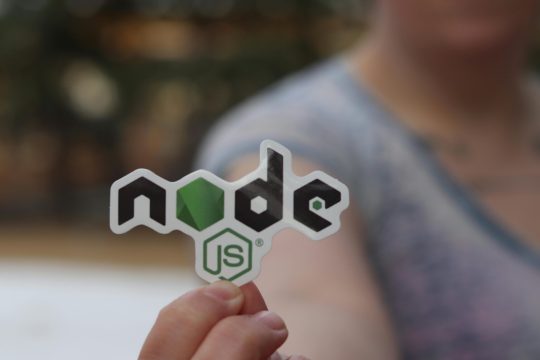
In today’s data-driven world, businesses require agile and scalable solutions to manage ever-growing information. The dynamic duo of MongoDB and Node.js offers a powerful combination to address these challenges. This blog delves into how MongoDB, a NoSQL document database, and Node.js, a JavaScript runtime environment, seamlessly integrate to create robust and scalable business solutions.
Why MongoDB? A Document-Oriented Approach
Traditional relational databases (RDBMS) excel in structured data with predefined schemas. However, modern applications often deal with complex, evolving data structures that don’t fit neatly into rigid relational models. MongoDB breaks free from these limitations.
Here’s what makes MongoDB shine:
● Flexible Schema:
MongoDB utilizes a document-oriented approach. Documents are JSON-like structures that can store diverse data types, including arrays and embedded objects. This flexibility allows you to accommodate evolving data models without schema changes, a major advantage for agile development.
● Horizontal Scalability:
MongoDB scales horizontally by sharing data across multiple servers. This allows you to handle increasing data volumes by adding more servers, ensuring your database scales seamlessly with your business growth.
● High Performance:
MongoDB boasts impressive performance due to its in-memory data structures and efficient query execution. This translates to faster read and write operations, crucial for real-time applications.
Why Node.js? The JavaScript Advantage
Node.js brings a unique advantage to the table: JavaScript. As a single-threaded, event-driven environment, Node.js excels at handling a high volume of concurrent requests efficiently. Here’s how it complements MongoDB:
● JavaScript Familiarity
Node.js leverages JavaScript, a widely used language for front-end development. This familiarity empowers developers to work with both back-end and front-end logic using the same language, streamlining development and reducing the learning curve.
● Asynchronous Programming
Node.js’s non-blocking, asynchronous architecture aligns perfectly with MongoDB’s high-performance nature. This enables efficient handling of numerous concurrent requests without compromising responsiveness.
● Rich Ecosystem
The Node Package Manager (npm) provides a vast collection of open-source libraries and frameworks specifically designed for Node.js development. This includes powerful tools for interacting with MongoDB, such as Mongoose, a popular Object Data Modeling (ODM) library.
The Synergy: Building Scalable Solutions
The combined power of MongoDB and Node.js unlocks exciting possibilities for building scalable business solutions. Here are some compelling use cases with technical considerations:
Real-Time Applications
The duo excels in building real-time applications like chat rooms, social media platforms, and collaborative editing tools. MongoDB’s flexibility and Node.js’s event-driven architecture enable seamless data updates and a dynamic user experience.
Technical Considerations
Utilize Socket.IO, a popular real-time communication library for Node.js, to establish bi-directional communication between clients and servers. Implement efficient data serialization techniques (e.g., BSON) to minimize data transfer overhead.
IoT Applications
The ever-growing Internet of Things (IoT) landscape generates vast amounts of unstructured data. MongoDB’s flexible schema and horizontal scalability are ideal for storing and managing sensor data from connected devices, while Node.js facilitates efficient data processing and communication with devices.
Technical Considerations
Explore libraries like Mongoose to simplify data modeling for sensor data. Leverage Node.js’s streaming capabilities to handle high-velocity data streams from IoT devices. Consider implementing authentication and authorization mechanisms to secure communication between devices and the server.
E-commerce Platforms
Modern e-commerce platforms require managing a variety of product information, user data, and purchase histories. MongoDB’s flexibility and scalability cater to the ever-changing needs of e-commerce businesses, while Node.js delivers a robust back-end for handling transactions and user interactions.
Technical Considerations
Utilize MongoDB aggregation pipelines for efficient product search and filtering functionalities. Implement Node.js middleware to handle user authentication, authorization, and shopping cart management. Integrate payment gateways securely using established Node.js libraries.
Security Considerations
While MongoDB and Node.js offer remarkable advantages, security remains a crucial concern. Here are some best practices to follow:
Regular Updates: Maintain up-to-date versions of MongoDB and Node.js to benefit from the latest security patches. Regularly update any installed npm packages to address potential vulnerabilities.
Authentication and Authorization: Implement robust authentication and authorization mechanisms to control user access and prevent unauthorized data modification.
Input Validation: Validate all user input to prevent malicious code injection attacks like SQL injection and cross-site scripting (XSS). Sanitize and escape any user-provided data before storing it in MongoDB.
Secure Coding Practices: Follow secure coding practices on both the Node.js and database side to minimize security risks. This includes avoiding common vulnerabilities like insecure direct object references (IDOR) and using prepared statements for database queries.
Network Security: Implement network security measures like firewalls and access control lists (ACLs) to restrict unauthorized access to your MongoDB server and Node.js application.
Beyond the Basics: Performance Optimization
Optimizing performance is crucial for maintaining a smooth user experience in large-scale applications. Here are some tips for Node.js and MongoDB performance optimization:
Caching: Utilize caching mechanisms like Redis or Memcached to store frequently accessed data in memory, reducing the load on MongoDB.
Indexing: Create appropriate indexes in MongoDB for frequently used queries to improve query performance.
Profiling: Use profiling tools for both Node.js and MongoDB to identify bottlenecks and optimize code for better efficiency.
To Wrap It Up!
Integrating MongoDB with Node.js for data storage and retrieval presents a multitude of advantages, such as enhanced flexibility, scalability, performance, and robust querying capabilities. Collaborating with a reputable Node.js Development Company such as Force WebTech enables you to maximize the synergies between MongoDB and Node.js, empowering you to create cutting-edge web applications that excel in both performance and user experience. Reach out to Force WebTech now to explore how they can assist you in leveraging MongoDB and Node.js for your upcoming project.
Original Source: https://forcewebtech.com/blog/mongodb-node-js-for-scalable-business-solutions/
0 notes
Text
Gaining Skills in Full-Stack Development Your In-Depth guide for the MERN Stack
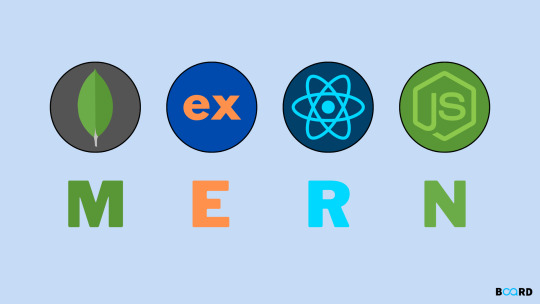
A powerful set of technologies called the MERN stack is employed in the development of dynamic and scalable web applications. It is the perfect option for developers that wish to work with JavaScript for both front-end and back-end development because it includes MongoDB, Express.js, React.js, and Node.js. You will learn the principles of each technology, how they interact with one another, and how to use them to create reliable applications in this course.
Setting Up Your Development Environment
Before diving into MERN stack development, it’s essential to set up your development environment properly. This includes installing Node.js and npm, setting up MongoDB, and configuring your code editor. We'll walk you through each step, ensuring you have all the tools and configurations needed to start building your MERN stack applications.
Building a RESTful API with Express and Node.js
Express and Node.js power a MERN stack application's back end. This section covers handling HTTP requests, managing routes, and building a RESTful API. We'll go over key ideas including managing errors, integrating MongoDB for data storage and retrieval, and middleware.
Using React.js for Front-End Design
The component-based architecture and effective dynamic UI rendering of React.js are well-known. You will gain knowledge about handling user interactions, handling reusable components, and using hooks to manage state. In MERN stack development course advanced topics like Redux for state management in larger applications and React Router for navigation will also be covered.
Connecting the Front-End and Back-End
In a MERN stack application, seamless front-end and back-end integration is essential. This section will walk you through the process of sending HTTP requests from your React components to the Express API using Axios or the Fetch API. You will gain knowledge about managing data retrieval, authentication, and client-server synchronization.
Implementing Authentication and Authorization
Using Authentication and Authorization Security is an essential part of developing websites. We'll go over how to use JSON Web Tokens (JWT) for user authentication and authorization in this section of the course. You'll discover how to manage user sessions, safeguard routes against unwanted access, and develop safe login and registration routes.
Deploying Your MERN Application
The last stage is deployment, which comes once your application is finished. We'll guide you through the process of launching your MERN stack application on an AWS or Heroku cloud platform. You will gain knowledge of setting up environment variables, optimizing your server for production use, and making sure your application is effective and scalable.
Advanced Methods for MERN Stacking
We'll dive into advanced methods and best practices to help you develop your abilities. Performance optimization, real-time functionality implementation using WebSockets, and more efficient data searching with GraphQL are all included in this. These advanced topics will improve your skills as a full-stack developer and get you ready to take on challenging tasks.
Introduction to JavaScript
The foundation of the MERN stack is JavaScript, and efficient development requires an awareness of its contemporary features. We'll go over key JavaScript ideas and ES6+ features like async/await, template literals, destructuring, and arrow functions in this section. These improvements make the code easier to read and maintain while also making it simpler.
The NoSQL Database, MongoDB
A NoSQL database that is document-oriented, MongoDB enables scalable and adaptable data storage. The basics of MongoDB, such as collections, documents, and CRUD functions, will be covered. Additionally, you will learn how to enforce data formats and expedite database operations with Mongoose, an Object Data Modeling (ODM) module for MongoDB and Node.js.
Building and Testing API Endpoints
Developing a strong API is an essential component of every web application. Building and testing API endpoints with Postman-like tools is the main topic of this section. To make sure your API is dependable and error-free, you'll learn how to organize your routes, verify incoming data, and put unit and integration tests in place.
Overview of Component Libraries
Use component libraries like Material-UI or Ant Design to improve your React apps. These libraries include pre-made, editable user interface components that can greatly expedite development and guarantee a unified design. We'll go over how to include these libraries into your project and modify individual parts to suit the requirements of your application.
State Management with Context API and Redux
Effective state management is key to maintaining an organized and scalable React application. We’ll start with the Context API for simple state management scenarios and then move on to Redux for more complex applications. You’ll learn how to set up a Redux store, create actions and reducers, and connect your components to the store using React-Redux.
Handling Forms and Validation
Forms are a critical part of user interaction in web applications. This section covers how to handle form input, manage form state, and implement validation using libraries like Formik and Yup. You’ll learn best practices for creating dynamic and user-friendly forms that enhance user experience.
Real-Time Data with WebSockets
Adding real-time functionalities can significantly enhance user experience in web applications. We'll introduce WebSockets and Socket.io to implement real-time data updates. You’ll learn how to set up a WebSocket server, handle real-time events, and create interactive features such as live chat and notifications.
Using GraphQL with MERN
GraphQL is an alternative to REST that allows for more flexible and efficient data querying. This section will introduce you to GraphQL and how to integrate it with your MERN stack application. You’ll learn how to create GraphQL schemas, write resolvers, and make queries and mutations from your React components.
Testing Your React Components
Testing is an essential part of the development process. This section will cover how to write tests for your React components using testing libraries such as Jest and React Testing Library. You’ll learn how to write unit tests, mock dependencies, and ensure your components behave as expected under various scenarios.
Continuous Integration and Deployment (CI/CD)
Implementing a CI/CD pipeline ensures that your application is tested and deployed automatically whenever you make changes. This section will guide you through setting up CI/CD workflows using services like GitHub Actions or Jenkins. You’ll learn how to automate testing, build processes, and deploy your MERN stack application seamlessly.
Exploring the Ecosystem and Community
The MERN stack has a vibrant and active community that continuously contributes to its ecosystem. This section highlights valuable resources, including forums, documentation, and open-source projects. Engaging with the community can provide support, inspiration, and opportunities to collaborate on exciting projects.
Conclusion
After completing the MERN stack development course in every aspect, you have acquired important information and abilities. Continue developing your own apps, participating in initiatives, and investigating new technologies as you advance. Your newly acquired abilities will be a strong starting point for a profitable full-stack development career. The web development industry is a dynamic and ever-changing field, and with the MERN stack, you're prepared to take on any problem that may arise.
0 notes
Text
Full Stack Developer Course Syllabus at SyntaxLevelUp
Embarking on a journey to become a Full Stack Developer requires mastering a wide range of skills, from front-end technologies to back-end systems, and everything in between. At SyntaxLevelUp, our Full Stack Developer course is designed to equip you with the comprehensive knowledge and hands-on experience necessary to excel in the tech industry. Here’s an in-depth look at our syllabus:

Module 1: Introduction to Full Stack Development
- Overview of Full Stack Developer training in pune: Understanding the roles and responsibilities of a Full Stack Developer.
- Development Environments: Setting up your development environment with tools like VS Code, Git, and GitHub.
- Version Control: Mastering Git and GitHub for collaboration and version management.
Module 2: Front-End Development
HTML & CSS
- HTML Fundamentals: Elements, attributes, forms, tables, and semantic HTML.
- CSS Basics: Selectors, properties, values, and CSS Grid/Flexbox.
- Responsive Design: Media queries, mobile-first design, and frameworks like Bootstrap.
- Advanced CSS: Animations, transitions, and preprocessors like SASS.
JavaScript
- JavaScript Essentials: Variables, data types, operators, and control structures.
- DOM Manipulation: Selecting and manipulating DOM elements, event handling.
- ES6+ Features: Arrow functions, destructuring, spread/rest operators, and modules.
- Asynchronous JavaScript: Promises, async/await, and AJAX.
Front-End Frameworks and Libraries
- React Basics: Components, JSX, props, state, and lifecycle methods.
- Advanced React: Hooks, context API, and performance optimization.
- State Management: Introduction to Redux and managing state in complex applications.
- Routing: Implementing React Router for single-page applications (SPAs).
Module 3: Back-End Development
Node.js & Express.js
- Node.js Fundamentals: Setting up Node.js, understanding the event loop, and NPM.
- Express.js Basics: Setting up Express, routing, middleware, and RESTful APIs.
- Database Integration: Connecting to databases like MongoDB, using Mongoose for schema definitions and data manipulation.
Databases
- SQL Databases: Introduction to SQL, relational database concepts, and working with MySQL/PostgreSQL.
- NoSQL Databases: Understanding NoSQL, document databases, and working with MongoDB.
Module 4: Full Stack Integration
- API Development: Creating and consuming RESTful APIs, understanding HTTP methods and status codes.
- Authentication & Authorization: Implementing user authentication with JWT, OAuth, and secure password storage.
- File Handling: Uploading and managing files in a web application.
Module 5: DevOps and Deployment
- Deployment Strategies:
Deploying applications using platforms like Heroku, AWS, and Netlify.
- CI/CD Pipelines: Introduction to Continuous Integration and Continuous Deployment with tools like Jenkins and GitHub Actions.
- Containerization: Docker basics and creating Docker images for consistent development environments.
Module 6: Capstone Project
- Project Planning: Designing and planning a full-stack training in pune application from scratch.
- Implementation: Building the project using the skills learned throughout the course.
- Testing & Debugging: Writing unit tests, integration tests, and using debugging tools.
- Presentation: Preparing and presenting your project to peers and instructors for feedback.
Additional Resources
- Soft Skills Development: Communication, teamwork, and problem-solving.
- Career Guidance: Resume building, portfolio development, and interview preparation.
Conclusion
Our Full Stack Developer course in pune at SyntaxLevelUp is meticulously crafted to provide you with a solid foundation in both front-end and back-end development. By the end of this course, you will be equipped with the skills and confidence to build and deploy full-stack applications, paving the way for a successful career in tech. Enroll today and take the first step towards becoming a proficient Full Stack Developer!
SyntaxLevelUp offers top-tier full stack training in Pune, designed to transform beginners into proficient developers. Our full stack developer classes in Pune cover a comprehensive curriculum, including HTML, CSS, JavaScript, React, and Node.js. Recognized as the best full stack developer course in Pune, our program combines theoretical knowledge with practical projects. Whether you're looking for full stack developer courses in Pune or full stack classes in Pune, SyntaxLevelUp provides hands-on experience, expert mentorship, and career guidance to ensure your success in the tech industry. Join us and elevate your skills with the finest full stack training in Pune.
#full stack training in pune#full stack developer classes in pune#best full stack developer course in pune#full stack developer course in pune#full stack courses in pune#full stack classes in pune#full stack developer#full stack training
0 notes
Text
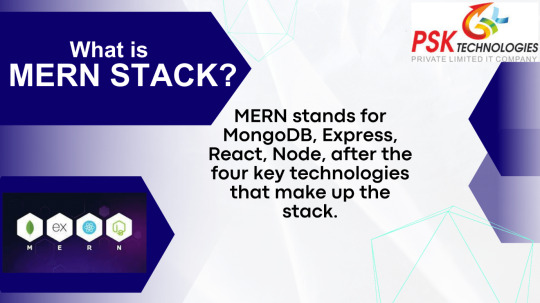
In the dynamic landscape of web and mobile application development, leveraging the power of the MERN stack (MongoDB, Express.js, React, Node.js) combined with cloud technologies has become a hallmark of modern software engineering. This comprehensive guide delves into the realm of professional MERN stack development on the cloud, exploring the synergy between these technologies and how they empower developers to craft robust, scalable, and efficient applications.
Unveiling the MERN Stack
The MERN stack encompasses a set of JavaScript-based technologies that seamlessly blend to create full-stack applications. It comprises:
MongoDB: A NoSQL database that provides flexibility in handling unstructured data and scalability for large datasets.
Express.js: A fast and minimalist backend framework for building APIs and handling HTTP requests.
React: A powerful frontend library for crafting interactive user interfaces using reusable components.
Node.js: A server-side runtime environment that allows developers to execute JavaScript code outside a web browser.
The Cloud Advantage
Incorporating cloud technologies into MERN stack development brings a multitude of benefits, ranging from scalability to security. Leading cloud providers like AWS, Azure, and Google Cloud offer a wide array of services that enhance the development process:
Scalability and Elasticity
Cloud platforms enable seamless horizontal and vertical scaling, allowing applications to accommodate varying levels of traffic. With auto-scaling features, resources are allocated dynamically, ensuring optimal performance without manual intervention.
Deployment Made Effortless
Deploying MERN stack applications on the cloud is streamlined through services such as AWS Elastic Beanstalk or Google App Engine. These platforms abstract away infrastructure management, enabling developers to focus solely on code deployment.
Robust Data Management
Integrating MongoDB with cloud-based databases like MongoDB Atlas ensures data durability, high availability, and automated backups. This provides developers with a solid foundation for managing critical application data.
Security Reinforcement
Cloud platforms offer a plethora of security features, including identity and access management, encryption, and compliance certifications. This is particularly critical when handling sensitive user data.
Continuous Integration and Deployment (CI/CD)
Implementing CI/CD pipelines using cloud-native tools automates the build, test, and deployment processes. This results in faster iterations, reduced manual errors, and enhanced collaboration among development teams.
Cost Optimization
Cloud-based solutions allow developers to pay only for the resources they consume. This cost-effectiveness is particularly advantageous for startups and businesses with fluctuating resource needs.
Crafting the Development Process
The journey of professional MERN stack development on the cloud involves several pivotal steps:
Environment Setup
Prepare your development environment by installing Node.js and npm. Initialize your project directories and create distinct package.json files for both the front end and back end.
Backend Implementation
Design your API structure and endpoints using Express.js. Connect to MongoDB using Mongoose for efficient data storage and retrieval.
Frontend Creation
Construct React components to form your application’s user interface. Utilize state and props for dynamic data management and incorporate third-party libraries for enhanced functionality.
Cloud Integration
Choose a cloud provider and set up the necessary services. Deploy your backend using serverless functions, virtual machines, or containers. Utilize cloud databases for optimal data management.
CI/CD and Monitoring
Implement CI/CD pipelines to automate testing, building, and deployment. Set up monitoring and logging tools to track performance and identify issues promptly.
Security and Optimization
Prioritize security by implementing encryption, authentication, and input validation. Optimize your application for performance by employing caching strategies and code optimization techniques.
Embracing the Future
The fusion of the MERN stack with cloud technologies unlocks a realm of possibilities for web and mobile application development. The seamless integration of MongoDB, Express.js, React, and Node.js with cloud platforms empowers developers to create applications that are not only feature-rich and scalable but also highly resilient and secure. By embracing this synergy, developers can navigate the ever-evolving landscape of technology and bring their innovative visions to life like never before.
-BALVESH PURAMKAR
Intern, PSK Technologies
1 note
·
View note
Text
Master the Stack: Node.js, Express.js, MongoDB & Netlify
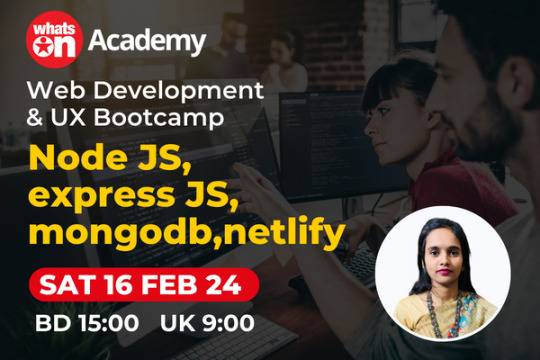
Embark on an Exciting Tech Voyage: Plunge into the Leading Edge of Technology with WhatsOn IT Academy's Deep-Dive Course on February 16, 2024, at 15:00 in BD Time and 9:00 in UK Time. Delve into the vast and modern world of web development, with a comprehensive curriculum that covers everything you need to know about creating robust and resilient RESTful APIs. Elevate your coding abilities by securing your place today for an adventure into the upcoming era of technology! Node.js Fundamentals - Understand Node.js as a JavaScript runtime environment. - Install Node.js and npm, create a project directory, and initialize it. - Revisit basic JavaScript concepts if needed. - Explore using npm to manage dependencies. - Write and run simple Node.js scripts. Building with Express.js - Understand Express.js as a web framework for Node.js. - Learn about routes, handling requests, sending responses. - Create a basic server with Express to serve static files. - Define routes for different URL paths and handle requests accordingly. - Introduce templating engines like EJS or Pug for dynamic content. Connecting to MongoDB - Understand MongoDB as a NoSQL database with document-oriented storage. - Install MongoDB locally or use a cloud service like MongoDB Atlas. - Learn Mongoose as an ODM (Object Data Modeling) library for MongoDB in Node.js. - Connect your Node.js application to the MongoDB database. - Perform Create, Read, Update, delete operations on your MongoDB data using Mongoose. Deployment with Netlify - Understand Netlify as a platform for hosting static websites and web applications. - Explore options like Netlify Functions for serverless functions or static site deployment. - Set up your project for deployment on Netlify. - Push your code to a Git repository and deploy to Netlify. - Verify your application works as expected after deployment. Don't miss this exceptional opportunity to unlock your full potential as a web developer! Secure your spot in this transformative course today and embark on an exciting voyage into the future of technology. Join Now Join WhatsOn IT Academy Facebook Group– Link Read the full article
0 notes
Text
Unveiling the Power of MERN Stack: A Comprehensive Guide
In the ever-evolving landscape of web development, choosing the right technology stack is crucial for building robust and scalable applications. One such powerful and popular stack is the MERN stack, comprising MongoDB, Express.js, React.js, and Node.js. In this blog post, we will dive into the intricacies of each component and explore how they seamlessly work together to create dynamic and feature-rich web applications.
MongoDB:
MongoDB, a NoSQL database, forms the 'M' in MERN stack. Its flexible schema allows developers to store data in a JSON-like format, making it easy to handle and manage large amounts of structured and unstructured data. MongoDB's scalability and high performance make it an ideal choice for applications with rapidly changing data requirements.
Express.js:
Express.js, often referred to as the 'E' in MERN stack, is a minimalistic and flexible Node.js web application framework. It simplifies the process of building robust and scalable web applications by providing a set of features for web and mobile applications. Express.js facilitates the creation of server-side logic, routing, and middleware, streamlining the development process and enhancing the overall performance of the application.
React.js:
React.js, the 'R' in MERN stack, is a JavaScript library for building user interfaces. Developed and maintained by Facebook, React.js enables the creation of interactive and dynamic user interfaces with ease. Its component-based architecture allows developers to build reusable UI components, making the codebase modular and maintainable. React.js also provides a virtual DOM, which enhances the application's performance by minimizing unnecessary updates and rendering only the components that have changed.
Node.js:
Node.js forms the 'N' in MERN stack and serves as the runtime environment for executing server-side JavaScript code. With its non-blocking, event-driven architecture, Node.js enables the development of highly scalable and performant applications. Node.js seamlessly integrates with Express.js, allowing developers to build a complete web application using JavaScript for both the client and server sides.
Building a MERN Stack Application:
To showcase the power of MERN stack, let's walk through the process of building a simple task management application:
a. Setting up the environment:
Install Node.js and npm
Set up a MongoDB database
Create a new React.js application using create-react-app
Initialize an Express.js server
b. Connecting MongoDB with Express.js:
Use Mongoose, an ODM (Object Data Modeling) library, to interact with MongoDB
Define models and schemas for the application's data
c. Building the frontend with React.js:
Create components for tasks, user interface, and interactions
Use React Router for navigation between different views
Fetch and display data from the Express.js API
d. Implementing server-side logic with Express.js:
Set up routes for handling CRUD (Create, Read, Update, Delete) operations
Implement middleware for authentication and error handling
e. Deploying the MERN stack application:
Choose a hosting provider (e.g., Heroku, AWS, or DigitalOcean)
Configure the deployment environment
Deploy both the frontend and backend components
Conclusion:
The MERN stack provides a powerful and efficient framework for developing modern web applications. MongoDB, Express.js, React.js, and Node.js complement each other seamlessly, enabling developers to build scalable, performant, and feature-rich applications. As you embark on your journey with MERN stack development, explore the vast ecosystem of libraries and tools available to enhance your productivity and create cutting-edge web solutions. Happy coding!
1 note
·
View note